Even if we do not live in Sardinia, a small presence of that island binds us to the culture of those areas. Perhaps you have heard of it, or perhaps you have tasted a preparation based on this green ingredient. We are talking about the myrtle, Myrtus communis, an evergreen shrub widespread in the Mediterranean scrub. For a long time this species has begun to fascinate us, not only for its appearance, but also and above all for its history and for the culinary tradition that sees it as an essential element.
Even if we do not live in Sardinia, a small presence of that island binds us to the culture of those areas. Perhaps you have heard of it, or perhaps you have tasted a preparation based on this green ingredient. We are talking about the myrtle, Myrtus communis, an evergreen shrub widespread in the Mediterranean scrub. For a long time this species has begun to fascinate us, not only for its appearance, but also and above all for its history and for the culinary tradition that sees it as an essential element.
The image of the myrtle is closely linked to Greek mythology, which sees the etymology of the name coincide with that of Myrsìne, a young girl who died for beating a challenger during a sports competition and transformed by Athena into a myrtle bush. . Hence the plant is used during the Olympic Games to adorn the crowns of the winners. Even in Roman mythology, myrtle finds a place of honor, as it is used as for the Greeks in the celebration of triumphs. It would then seem that Venus, goddess of love and beauty, after emerging from the sea foam, had hidden herself just behind a myrtle bush.
The image of the myrtle is closely linked to Greek mythology, which sees the etymology of the name coincide with that of Myrsìne, a young girl who died for beating a challenger during a sports competition and transformed by Athena into a myrtle bush. . Hence the plant is used during the Olympic Games to adorn the crowns of the winners. Even in Roman mythology, myrtle finds a place of honor, as it is used as for the Greeks in the celebration of triumphs. It would then seem that Venus, goddess of love and beauty, after emerging from the sea foam, had hidden herself just behind a myrtle bush.
After antiquity, the use of this plant in the culinary tradition, however, had to leave room for the importation of pepper and then of chilli pepper, thus returning limited to Italian cuisine, but above all Sardinian. In the first place it should be mentioned its use in the production of myrtle liqueur, already known and widely produced in Roman times. Did you know that there are two different myrtle liqueurs? In fact, we speak of red liqueur (of myrtle) referring to that obtained by macerating the berries in alcohol; we speak of white liqueur instead if the preparation is made only with leaves and shoots.
The aroma of myrtle also goes well with meat dishes, such as game, roasts and pork, and with shellfish, as in the case of the red shrimp in Alghero. Also try the making of the jam, excellent for pies. In Salento and Taranto, the flavor of grilled meat is still enhanced today with sprigs of myrtle.
The plant
Myrtus communis is a shrubby, aromatic, rustic plant that grows spontaneously in the Mediterranean area and is particularly luxuriant in Sardinia and Corsica. Myrtle is a splendid example of an ornamental plant both as an isolated bush or small tree and as a hedge. The abundant flowering, which appears in late spring and lasts throughout the summer, and the production of berries in the autumn make myrtle a valid candidate to enrich your garden. Evergreen and resistant to cold, myrtle prefers sunny exposures and well-drained soils, not particularly tolerating water stagnation.











